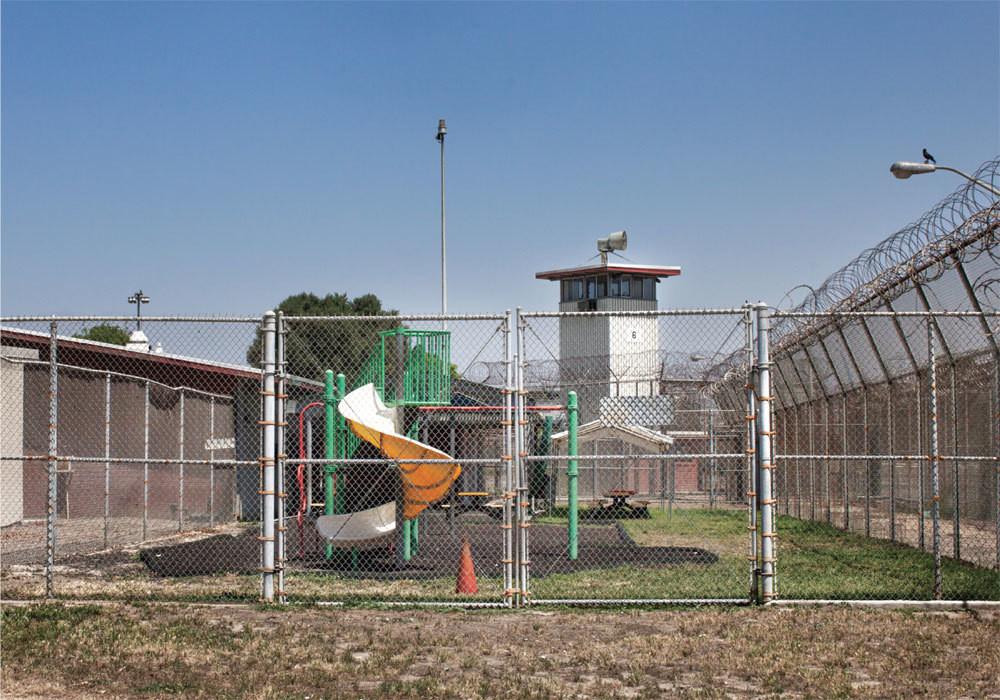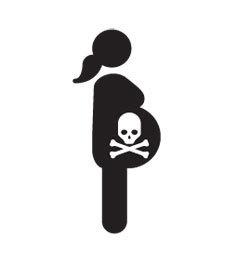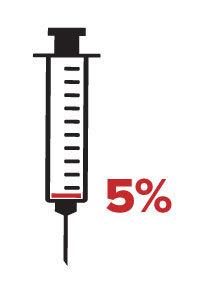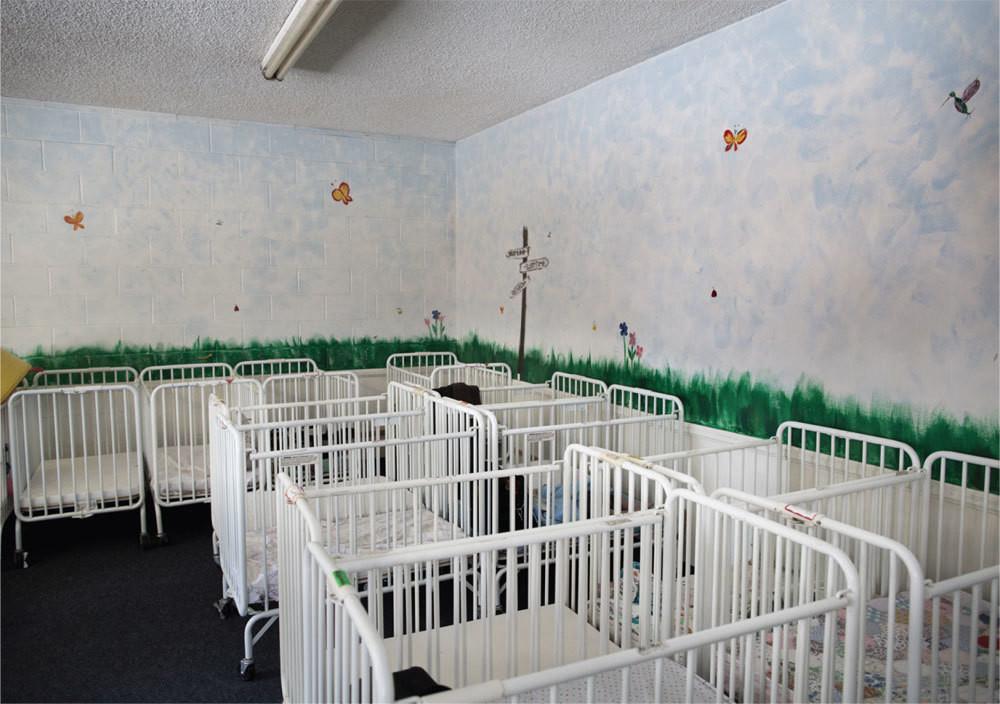
A playground at the visitation center of the California Institution for Women, in Corona, where children are allowed to visit their mothers. The photos featured here are from Mae Ryan’s ongoing series ‘Pregnant in Prison.’
This article appears in VICE Magazine’s October Prison Issue
Thirty-three-year-old Purvi Patel caught the attention of Indiana authorities in July 2013, when she entered a hospital for heavy bleeding she told doctors was the result of a miscarriage. Patel, who is not believed to have received prenatal care and had been hiding the pregnancy from her conservative Hindu family, is alleged to have taken abortifacients she purchased online from a pharmacy overseas. She admitted that she’d put the fetus in a dumpster, emphasizing that she’d thought it to be dead.
Videos by VICE
Patel stressed that she believed she’d been only two months pregnant at the time of her miscarriage, but expert witnesses at her trial estimated her gestation to be past Indiana’s 20-week window for legal abortion. The prosecution put forth a bizarre and highly disputed “lung float” theory, asserting that because the fetus’s lung floated when tested, Patel had actually delivered a living, breathing baby and left it to die. The jury agreed and convicted her of two crimes: neglect of a dependent and feticide, which Indiana law defines as the termination of a pregnancy that does not occur with the intent to deliver a live birth. The law does not apply to abortion, and was intended to create legal recourse for violent attacks that caused a woman to miscarry.
Read on i-D: Photographing America’s Pregnant Prisoners
This March, Patel became the first US woman charged, convicted, and sentenced—to 20 years in prison—for “feticide” related to her own abortion attempt.
Her case immediately became a rallying cry among pro-choice advocates who point out that pro-lifers have long maintained that the criminalization of abortion would target only shady providers, not the women seeking them.
Patel’s case may be an anomaly, but it reflects a nationwide climate in which the Supreme Court’s Roe v. Wade ruling that fetuses are not separate people with separate rights is routinely challenged. Restrictions to abortion have spiked in recent years.
“We are seeing an extraordinary backlash against women’s equality and status as constitutional persons,” said Lynn Paltrow, executive director of National Advocates for Pregnant Women (NAPW), adding that anti-abortion measures defining life as beginning with conception “are providing the grounds for locking pregnant women up.”

Prison guards escort inmates to their ob-gyn appointments at the California Institution for Women. Pregnant women get pre-and post-natal care at the prison, though Brittany Bass, who gave birth at the facility, said, “There’s really no aftercare here. They just handed me a Kotex pad and said, ‘Have a good day.’”
Predating the Patel case was that of Bei Bei Shuai, a Chinese immigrant in Indiana who was jailed for more than a year on feticide charges related to her attempting suicide while pregnant. She accepted a plea deal for criminal recklessness and received a sentence of time served in 2013.
“Attempting suicide is not a crime in Indiana. But according to Indiana prosecutors, if the person attempting suicide is a pregnant woman, she can be punished severely under the state’s feticide law,” Paltrow said. “This makes pregnant women separate and unequal under the law. It makes their depression, their hopelessness crimes rather than public health issues.”
Shuai and Patel aren’t the first women to be punished for crimes committed against their own fetuses. In a peer-reviewed study published in the Journal of Health Politics, Policy and Law, Paltrow and the report’s co-author identified more than 400 arrests, detentions, and forced medical interventions for which a woman’s pregnancy was a “necessary factor” between 1973, the year of the Roe v. Wade decision, and 2005.
Even when women were not charged with feticide, prosecutors operating with wide discretion have employed anti-abortion measures defining a fetus as a child as the basis to prosecute other crimes committed against the “unborn.”
More than 80 percent of the cases identified by NAPW involved a charge of using an illegal substance, most often cocaine, a drug with an important history in the criminalization of pregnant women. The moral judgment of behavior during pregnancy is linked closely to the now debunked “crack baby” hysteria of the crack-cocaine era.

TOXIC WOMB
In 2014, Alabama’s supreme court ruled that the 2006 “chemical endangerment of a child” law applied to fetuses. Since the law was created, more than 180 new mothers have been prosecuted for their allegedly toxic wombs, even though the law originally targeted parents who allowed children in meth labs.
“Basically, since the 1980s, prosecutors started charging pregnant women who use drugs with crimes like child endangerment or delivering drugs to a minor… and in almost every state except South Carolina and Alabama, the courts invalidated those prosecutions,” Linda Fentiman, a Pace University professor specializing in health and criminal law, told me. Legislators then introduced fetal homicide bills, often during the wake of a horrific attack on a pregnant woman, as a legal precedent under which to hold an assailant criminally responsible for ending a pregnancy.
The first woman to be convicted of homicide by child abuse due to her behavior during pregnancy—drug use—is believed to be Regina McKnight, who was arrested in 1999 and then sentenced to 12 years in prison for a stillbirth she allegedly caused by taking cocaine. The Supreme Court of South Carolina overturned her conviction in 2008, ruling that McKnight had received inadequate counsel and was convicted on the basis of “outdated” assumptions about the harms of prenatal exposure to cocaine. As an amicus brief filed with the court explained, “[C]ocaine is no more harmful than nicotine use, poor nutrition, lack of prenatal care, or other conditions commonly associated with the urban poor.”
Nonetheless, bad science—particularly when it pertains to pregnant women’s drug use—has since remained a staple of the prosecutions of pregnant women. “Medical misinformation and false claims about the relative risks of harm from drug use during pregnancy are often the basis for prosecutions of pregnant women and laws targeting them for special penalties,” Paltrow said. “It is as if lawmakers and prosecutors are not only saying that pregnant women deserve to be punished, but also that they are a class of persons who do not deserve to have policy based on actual medical science.”
Last spring, the Tennessee legislature became the first to prosecute women for the health of their newborns with a “fetal assault” bill allowing for up to 15 years in prison for a person convicted of using narcotics that were proven to have harmed her baby during pregnancy. But it has long been established in the medical community that criminalizing addiction during pregnancy may actually deter women from receiving prenatal care, jeopardizing the health of both the mother and the fetus.
“Pregnant women will be likely to avoid seeking prenatal or open medical care for fear that their physician’s knowledge of substance abuse or other potentially harmful behavior could result in a jail sentence rather than proper medical treatment,” the American Medical Association’s Board of Trustees said more than two decades ago, in 1990. The AMA is just one of nearly every major medical organization that has publicly objected to the criminalization of drug use during pregnancy.

PREGNANT DRUG USERS
Five percent of pregnant women between the ages of 15 to 44 were illicit drug users from 2012 to 2013.
“What Tennessee did very much flew in the face of national recommendations,” Allison Glass, state director of Healthy and Free Tennessee, told me. Neonatal abstinence syndrome (which occurs when a newborn withdraws from opioids) is a treatable condition and has not definitively been linked to any long-term health risks for the child.
Back in 1997, the South Carolina Supreme Court ruled that fetuses are included in the state’s criminal child-abuse statute, and that drug use during pregnancy may be considered criminal child abuse. Over the past decade, NAPW counted more than 70 pregnancy-linked child-abuse prosecutions in South Carolina.
Last year in Alabama, the state’s supreme court ruled that the 2006 “chemical endangerment of a child” law applied to fetuses. The law was intended to prosecute parents who allowed children in methamphetamine labs, but since the law’s inception in 2006, NAPW has counted more than 180 new mothers prosecuted for their allegedly toxic wombs.
These prosecutions seem to imply that drug use during pregnancy is rampant, but it’s not. The Substance Abuse and Mental Health Services Administration says that, from 2012 to 2013, just over 5 percent of pregnant women aged 15 to 44 were illicit drug users.
Women in states that don’t have such laws on the books are still at risk of being charged with crimes against their fetuses, and rogue prosecutors can use their wide discretion to prosecute mothers with crimes beyond feticide or child abuse. In New York, for example, Jennifer Jorgensen is currently appealing her conviction of manslaughter in the death of the fetus she was carrying when she caused a car wreck that killed two other passengers in another vehicle. Jorgensen was acquitted of driving under the influence and manslaughter related to those deaths, but the manslaughter charge for the fetus inside her belly at the time of the crash (which died after an emergency C-section later) stuck.

The Community Prisoner Mother Program in Pomona, California, allows a select group of low-level offenders to live with their young children until they turn seven years old. But there’s just one such facility open in the state, and it can only serve up to 24 inmates.
Because New York homicide law defines a victim as a person born alive, Jorgensen’s attorney says her conviction is unfounded and sets a standard allowing for prosecutions of mothers on charges dangerously outside the law. “This case, in the State of New York, is unprecedented,” her attorney argued in court. “It is impossible to commit this crime. At the time of the reckless acts, the victim did not legally exist.”
Jorgensen echoed reproductive rights advocates concerned about how the criminalization of mothers for crimes against a fetus could become a slippery slope and urged the court to think of how her case might impact other women.
“Any time a pregnant woman slips on the ice, she is going to be subject to criminal prosecution,” Jorgensen testified. “I did nothing wrong. This [case] isn’t about me. It’s about every single pregnant woman in the State of New York. It means if my conviction stands, they need to get pregnancy police.”
Tennessee’s fetal-assault bill will sunset in 2016, and advocates are working to prevent other states from adopting laws like it, to ensure that addiction during pregnancy is treated by medical professionals, not criminalized.
At an October symposium in Nashville, a group of national and statewide experts, Tennessee legislators, and community advocates will draft an executive summary highlighting how the law is impacting the state’s residents. Glass believes that the summary and evidence-based solutions to addiction presented will give local medical associations and legislators “all of the information they need to be able to help steer the conversation to where it needs to be, which is within the public health arena instead of the criminal justice system.”
“We realize that these types of punitive measures are not the way we’re going to build a healthy community,” Glass said. She hopes that the symposium will send the message that Tennessee does in fact care about people’s health.




